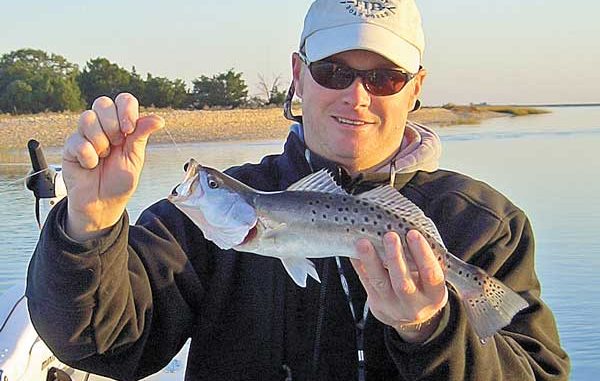
When Capt. George Poveromo came to Charleston in January for his annual Saltwater Sportsman Seminar Series, he was sure to ask “old salt” Don Hammond to help run the show. Hammond, retired from the South Carolina Department of Natural Resources, now heads up a private dolphin-tagging program. Addressing an auditorium crowded with fishermen, he said, “The difference between a nice boat ride and actually catching fish is often the techniques that will be taught here today.”
With freezing temperatures outside, saltwater anglers were content to spend a Saturday listening to a panel of fishing pros — local and otherwise — address topics ranging from offshore trolling and jigging to inshore fishing for trout, flounder and redfish.
Plenty of inshore fishing tips were provided, and Capt. John Ward of Affinity Charters advised anglers to venture out at low tide in order to locate structure like shells and oysters — a key to fishing success. He also discussed speckled trout, popping corks and how the two go together.
“We use a lot of popping corks when fishing for trout,” he said. “I like an 18- to 24-inch leader attached to a No. 1 circle hook. Be aggressive with the popping cork and pop it hard enough so you can hear it in the boat.”
The popping action also causes the bait to go up and down in the water column, said Ward, who added, “Look for trout in water depths from four to 12 feet.”
Capt. Chris Keen of Charleston’s Keen Eye Charters and Capt. Jimmy Price, a North Carolina trout and flounder expert, had different opinions.
“I like to fish a little deeper than that in winter time, and I cast my bait into the shallows and work the bait SLOWLY into the deeper water,” Keen said.
On the other hand, Price said, “I run way up the creeks, maybe three to five miles, to find the trout in winter — and I use soft plastic baits in a variety of colors.”
January’s cold weather brought up concerns about a trout die-off, but angler reports consistently tell of a story of a narrowly averted problem.
“About every three years, it gets cold enough to kill some trout, but this is totally cyclical, and the trout population will naturally come back after this stress,” said Hammond, who explained that specks become so cold that they become lethargic and are unable to swim against the current, which often leaves some stranded on flats, unable to survive.
With offshore season on the horizon, Poveromo rolled out some other pros to talk about tackle and tactics for the bluewater. Capt. Dick Vance of Charleston’s Hot Shot Charters said knows when he expects the popular dolphin (mahi-mahi) to arrive.
“My 30 years of records say that the first dolphin will show up about the third week in April,” he said. “Did you know that flying fish leave a stream of bubbles when they jump back into the water, and this is what chugger lures mimic so very well. I set my drag finger tight for the strike.”
Hammond drew on his deep knowledge of dolphin habits and said, “Our satellite tag-data shows where dolphin, and especially bull dolphin, frequent the most. Water temperatures between 79 and 81 degrees seem to be the magic spot for these bulls, so if you have a Roffer’s ocean forecast showing the thermal image of the Gulf Stream, you can determine where to troll. Look for weedlines in these temperature zones and don’t forget that edges of currents can hold baitfish.”
Harry Vernon III, owner of Capt. Harry’s Fishing Supply in Miami said that having a good set of “eyes” on board is a key to offshore fishing success.
“Finding the fish is always key, and I think that the gyroscope binoculars are the best way to go,” he said. “Always keep a man with a sharp eye stationed to scan to horizon. The captain usually studies the radar while navigating and figures out how to adjust the gain button in order to keep baitfish images from being fuzzy.”
On close encounters with offshore species, Vernon said, “Don’t ever think that your boat is scaring off the fish, because they often eat right behind the boat. I’ve seen it over and over again, so I’m convinced that the boat acts like a big teaser to the fish.”
Vance said to keep an ear open as well as your eyes.
“Don’t overlook scuttlebutt or dock knowledge when planning a trip, because offshore trolling results vary from day to day, and anglers are usually willing to share the techniques that were working for them,” he said. “This is not going to hold true for bottom fisherman, who would be less likely to give up information concerning their honey hole.”
Poveromo has conducted his seminar series for 24 years, during which saltwater fishing has been great for recreational fishermen. But he’s concerned that things are changing.
“Saltwater Sportsman is governed by conservation of species, and we stress catch and release fishing,” he said. “But there are severe threats to the future of saltwater fishing, like the red snapper closure, and the possibility remains that similar decisions could lead to other closures.”

Be the first to comment